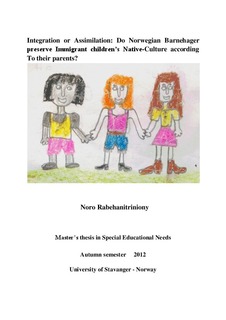| dc.contributor.author | Rabehanitriniony, Noro | |
| dc.date.accessioned | 2012-12-17T09:19:44Z | |
| dc.date.available | 2012-12-17T09:19:44Z | |
| dc.date.issued | 2012 | |
| dc.identifier.uri | http://hdl.handle.net/11250/185780 | |
| dc.description | Master's thesis in Special education | no_NO |
| dc.description.abstract | This paper presents a framework for understanding culture differences and immigrant parents’ points of view and experience with barnehager. The purpose of this study was to understand and have an overview over a few immigrant parents ‘cultural point of view and at the same time, identify integrative and/or assimilative patterns in their children’s life at a barnehage. Analyzing the immigrant parents ‘point of view about cultural differences based upon the integrative and assimilative perspectives can as well provide a new starting point for teaching and educational research, especially in Special Educational Needs. The priority concern of the present paper was to explore if immigrant parents claim that their children should be given the opportunity to be “themselves” at the barnehage, in addition that they get the chance to open up for new horizons. To get answers to the research question: Integration or Assimilation: Do Norwegian Barnehager preserve Immigrant children’s Native-Culture according To their parents? A semi-structured interview was conducted. Three immigrant parents from a collectivistic-oriented culture have taken part in the research interview. All three informants were chosen from barnehager which collaborate with the University of Stavanger thanks to a project called “Skoleklar”. The main findings from the research are as follows: two of the three immigrant parents interviewed were most of all concerned about transmitting their native-culture, such as mother-tongue and emotional heritages, to their children, inside the family-home and do not wish the barnehage staffs to convey their native-culture to their own children and other children at the barnehage. In other words: the two mothers can be said to practice assimilative integration, not integrative socialization, because they put a “boundary” between their children’s native-culture acquisition inside the family-home and the fact of letting the barnehage staff transmit their native- culture to their own children and other children at the barnehage. The last informant however claimed that the fact of transmitting her native-culture to her children inside the family-home, as well as the fact that the barnehage staffs transmitted her native-culture to both her children and other children at the barnehage was equally important to her. The latter can be said to practice integrative socialization. | no_NO |
| dc.language.iso | eng | no_NO |
| dc.publisher | University of Stavanger, Norway | no_NO |
| dc.relation.ispartofseries | Masteroppgave/UIS-HF-IGIS/2012; | |
| dc.subject | integration | no_NO |
| dc.subject | assimilation | no_NO |
| dc.subject | culture | no_NO |
| dc.subject | immigrant | no_NO |
| dc.subject | immigration | no_NO |
| dc.subject | parents | no_NO |
| dc.subject | acculturation | no_NO |
| dc.subject | barnehage | no_NO |
| dc.subject | spesialpedagogikk | no_NO |
| dc.subject | foreldre | |
| dc.subject | integrasjon | |
| dc.title | Integration or assimilation: do Norwegian barnehager preserve immigrant children’s native-culture according to their parents? | no_NO |
| dc.type | Master thesis | no_NO |
| dc.subject.nsi | VDP::Social science: 200::Education: 280::Special education: 282 | no_NO |
